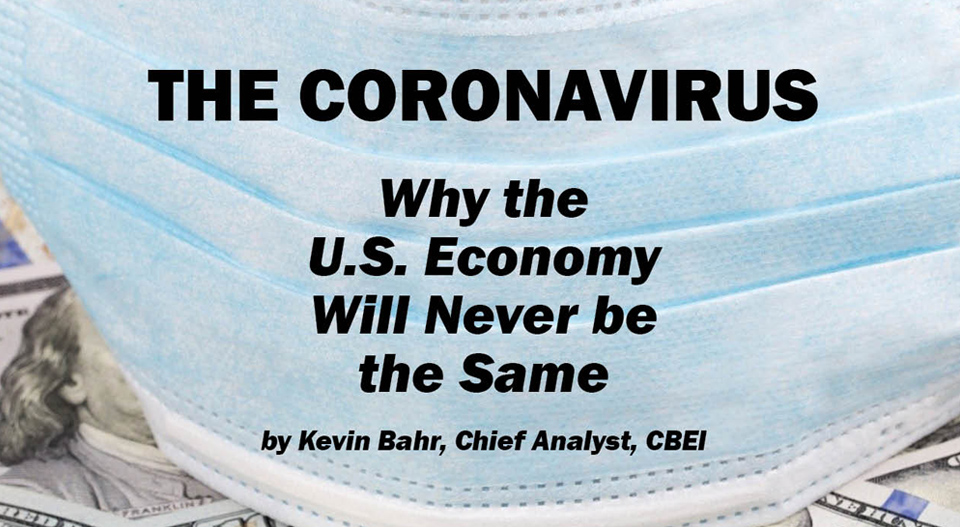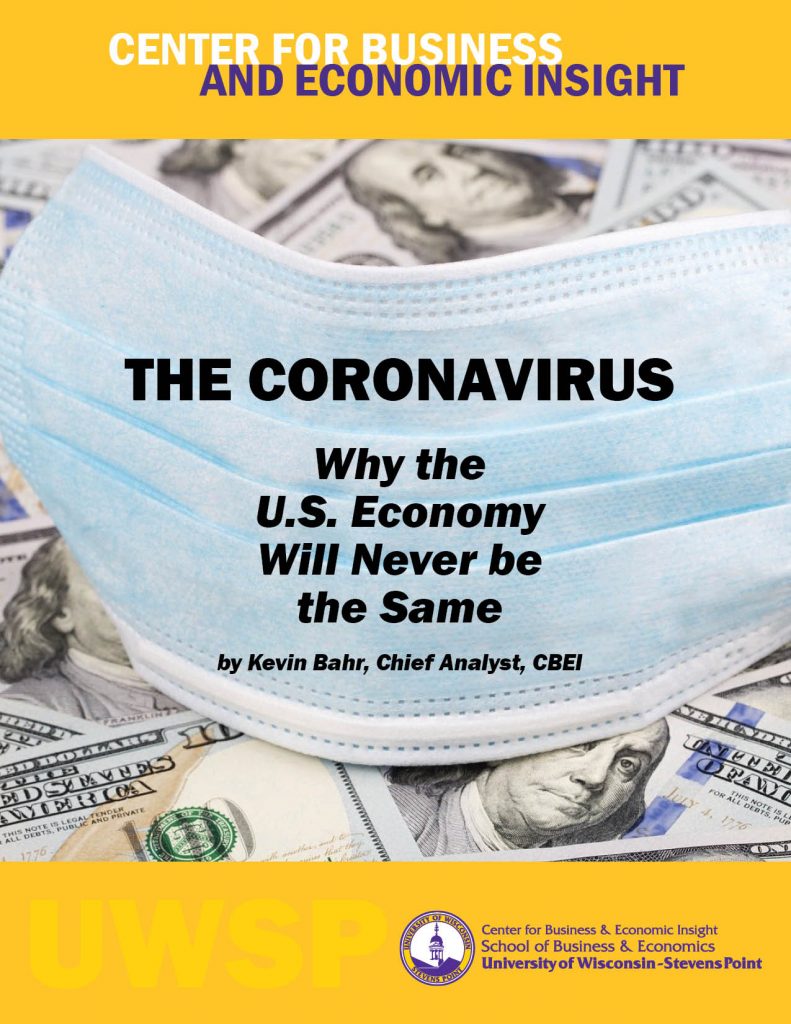
If there was any doubt about the severity of the coronavirus impact on the U.S. economy, those doubts came to an abrupt halt in March. The Department of Labor announced initial jobless claims soared to a seasonally adjusted 3.28 million in the week ended March 21, up from the prior week claims of only 282,000. An incredible, record one-week jump. Speaking of records, the nearly 3.3 million of initial jobless claims smashed the old record – by far. The previous high was 695,000 claims filed in the week ended Oct. 2, 1982. Although 3.3 million was a new record, unemployment claims doubled the following week to 6.65 million. Wisconsin wasn’t immune, with initial unemployment claims skyrocketing to over 51,000 for the week ended March 21 up from only 5,200 the prior week. The following week (March 28), there were over 115,000 claims according to the Wisconsin Department of Workforce Development.
With rare bipartisan support, most members of Congress realized that something had to be done – and quickly.
By the end of March, Congress passed and the President signed the Coronavirus Aid, Relief, and Economic Security (CARES) Act. CARES was the largest fiscal stimulus in the history of the United States – a $2 trillion stimulus package that more than doubled the $800 billion stimulus package that was implemented in 2009 to overcome the financial crisis. Certainly, the bill was not perfect, but it created a vast array of programs with bipartisan support that would provide economic support to individuals and businesses. The provisions included:
- $377 billion loan program for small businesses
The bulk of the program was $350 billion to provide eight weeks of cash-flow assistance to small businesses through 100 percent federally guaranteed loans to employers who maintain their payroll during this emergency. If employers maintain their payroll, the loans would be forgiven, which would help workers to remain employed and aid in the recovery of small businesses and the economy after the crisis. $10 billion will be for the Small Business Administration (SBA) emergency grants of up to $10,000 to provide immediate relief for small business operating costs; $17 billion will be for SBA to cover 6 months of payments for small businesses with existing SBA loans.
- $500 billion lending fund for distressed businesses
The provision increases the U.S. Treasury Department’s Exchange Stabilization Fund with $500 billion to aid large distressed firms, which the Federal Reserve can then leverage to inject approximately $4 trillion back into the marketplace in secured loans. An independent Inspector General and Congressional Oversight Panel will be established to oversee Treasury loans and investments – the loans must eventually be paid back following the coronavirus pandemic.
- Individuals (approx. $560 billion)
Each qualifying adult will receive up to $1,200 in the form of a one-time rebate check. The full amount is available for individuals with incomes up to $75,000 per year ($150,000 for married couples) before phasing out and ending altogether for those earning more than $99,000 ($198,000 for joint filers with no children). Families will receive an additional $500 per child. Included in the $560 billion is $260 billion for expanded unemployment insurance. An additional $600 per week payment to each recipient of unemployment insurance for up to four months. Funding will be provided to pay the cost of the first week of unemployment benefits through December 31, 2020 for states that choose to pay recipients as soon as they become unemployed instead of waiting one week before the individual is eligible to receive benefits. Finally, the expansion of unemployment insurance will provide an additional 13 weeks of unemployment benefits through December 31, 2020 to help those who remain unemployed after weeks of state unemployment benefits are no longer available.
- Public Health $153.5 billion – provisions include:
- Hospitals: $100 billion for hospitals responding to the coronavirus.
- Community health centers: $1.32 billion in funding for community centers that provide health care services
- Drug access: $11 billion for diagnostics, treatments and vaccines.
- Centers for Disease Control and Prevention: $4.3 billion for CDC programs and response efforts
- Veterans’ health care: $20 billion
- Medicine and supplies: $16 billion for the Strategic National Stockpile to increase availability of equipment, including ventilators and masks.
- State and Local Governments $339.8 billion
Included is $274 billion to help states fight covid-19, with $150 billion in direct aid for those state and local governments that are running out of cash. Also included is $5 billion for Community Development Block Grants, $13 billion for K-12 schools, $14 billion for higher education and $5.3 billion for programs for children and families, including immediate assistance to child-care centers.
- Safety net $26 billion
This includes $8.8 billion school meals, $450 million for food banks, and $15.5 billion for the Supplemental Food Nutrition Program (SNAP), in other words, food stamps.
- Student Loans
- The Department of Education will automatically suspend payments on Direct student loans without penalty through Sept. 30, 2020.
- Employers can provide up to $5,250 in tax-free student loan repayment benefits. That means an employer could contribute to loan payments and workers wouldn’t have to include that money as income.
The CARES Act was Phase III of a fiscal response to the coronavirus. In dollar amount, Phase III dwarfed the previous measures. Previous Phase I legislation included $8.3 billion in aid to help contain and treat the virus, including diagnostic testing and human vaccine clinical trials. Phase II (the Families First Coronavirus Response Act) legislation guaranteed free coronavirus testing, provided paid emergency leave, enhanced unemployment insurance, strengthened food security initiatives, and increased Federal Medicaid funding to states. The bill required governments and private businesses with fewer than 500 employees to provide up to two weeks of paid sick leave for those who miss work due to the coronavirus or for those who have to take care of family members affected by the pandemic. If needed, workers could take another 10 weeks off at two-thirds of their pay. A refundable tax credit is available to businesses and self-employed workers to cover the expense. The U.S. Labor Department could exempt companies with fewer than 50 workers if they risk going out of business.
The fiscal policy stimulus reflects the challenges of a service sector economy when consumer spending is declining. According to the U.S. Bureau of Labor Statistics, nonfarm payrolls in the private sector consisted of 128 million jobs as of February 2020. Out of those jobs, approximately 107.2 million (about 83 percent) were in the service sector, approximately 20.8 million (about 17 percent) were in the goods-producing sector. Many service sector jobs are in transportation, retail trade, restaurants, real estate, movie theaters – industries that depend on personal visits and service. Many of those jobs are within small businesses.
The Phase III fiscal policy also comes on the heels of the use of monetary policy by the Federal Reserve to bolster the sinking economy. Programs of the Federal Reserve included:
- Purchase at least $500 billion of Treasury securities
- Purchase at least $200 billion of mortgage-backed securities (including commercial)
- Creation of two credit facilities that support large employers through making loans and bond financing more accessible
- Additional credit facilities were created to help facilitate the flow of credit to consumers, small business, and municipalities
Collectively, the programs of the Federal Reserve were meant to increase access to credit and borrowing by consumers, business, and municipalities. The programs were in tandem with the Federal Reserve cutting the fed funds rate to 0.00–0.25% earlier in March.
Unfortunately, the fiscal and monetary policy actions were reactionary. Would they be enough to bail-out the economy? Probably not, but no one really knew. The ultimate impact of the coronavirus on the economy would be a function of how much it would spread, and how long it would last.
For further information on the CARES Act:
- From the Tax Foundation: Tax Foundation – CARES Act
- From NPR: NPR – CARES Act
CBEI Blog Series: The Coronavirus – Why the U.S. Economy Will Never be the Same
Part 1: What Happened – A Review of the Economic Impacts
Part 2: What Happened – A Review of the Stock Market
Part 3: What Will Change – Supply Chains
Part 4: What Will Change – Healthcare
Part 5: What Will Change – Deficits and Government Spending
Part 6: What Should Change – An Appreciation for Service Sector Workers
Part 7: What Should Change – Securities Regulation of Congress

Kevin Bahr is a professor emeritus of finance and chief analyst of the Center for Business and Economic Insight in the Sentry School of Business and Economics at the University of Wisconsin-Stevens Point.

